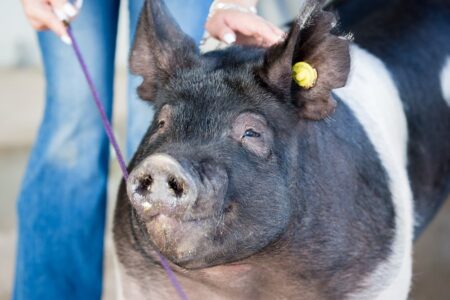Tractor development grew by leaps and bounds in the 1920s and 1930s, as droves of draft animals were herded away by engine-hungry farmers. A sure sign of the times, tractor sales had skyrocketed from around 250,000 in the early 1920s to well over 900,000 by 1930. Left in the dust of this stampede toward mechanized horsepower were small farms that couldn’t afford the large tractors of the time.
Ever the entrepreneur, Allis-Chalmers Tractor Division Manager Harry Merritt saw an opportunity in small farms. He ordered some market research, which readily confirmed that fact.
Allis-Chalmers marketers estimated that approximately 4 million small operators wanted affordable horsepower.
Affordability Was Key
In short order, Allis-Chalmers made small farmers’ dreams come true by creating a one-row tractor that wasn’t just affordable — it was also very modern.
Selling for just under $500 (which Allis-Chalmers estimated to be the cost of keeping a team of horses fed for a year) when it was introduced in 1937, the Model B was anything but bare bones.
Torque-Tube Pioneer
Eugene Blake
The 13-hp machine (it would later be upgraded to 20 hp) was fully modern. It featured a highly stylized wasp-waist torque-tube chassis that offered outstanding visibility. This carried high appeal for truck farmers and nursery growers.
That particular design, an industry first, would prove to be popular, because other manufacturers began employing that approach in their tractor designs, harvesting Allis-Chalmers a windfall of patent fees.
Clearance and Hydraulics
The B’s arched front axle and high rear-axle clearance was unlike anything on the market. These features allowed the tractor to readily navigate high-growing crops common on truck farms and vineyards.
The tractor could be ordered with a host of modern advances such as an optional hydraulic lift. In fact, the B would be the first Allis-Chalmers tractor to offer hydraulics. Noted industrial designer Brooks Stevens also gave the B an appealing look, with a stylized hood, fuel tank, and fenders that helped promote the tractor as state of the art. Those looks — plus a four-cylinder engine, three-speed transmission, and a wide array of implements — didn’t just catch the eye of small farms; the tractor caught on in huge fashion.
With the Model B, Allis-Chalmers knew what it was doing, engineering-wise. It had to be narrow (to run one-row equipment) and to offer high clearance. In the former case, the tractor’s front axle could be set for a 43- or 50-inch tread. For $20 extra, farmers could get an adjustable front axle, with 10 spacing increments ranging from 38–60 inches. The rear-wheel tread was changed with adjusting rims or clamps and reversing rear wheels.
The Model B’s Big Brother
Allis-Chalmers’ unique torque-tube chassis was expanded in the production of the Model C, introduced three years after the B, in 1940. However, not a great deal differentiated the Model C from the B. Both employed the same 125-cubic-inch engine and three-speed transmission. What made the C different was it had longer rear-axle sleeves that provided a 52–80-inch adjustable rear tread.
The C was offered with three different front axles that included an adjustable wide front, as well as single and dual narrow designs. During its 10-year production run, over 84,000 Model C’s were sold, which certainly testified to its popularity with small farmers.
A Big Hit Overseas
Eugene Blake
To gain height, Allis-Chalmers engineers designed an arched front axle and a high rear-axle clearance that made the Model B popular with truck farmers. That feature attracted foreign sales, as well. Since the B was shipped to Europe, Africa, Australia, and South America, it was one of the first truly international tractor models.
To back up these structural advantages, the B was given a high-torque, 113-cubic-inch Waukesha engine that turned out 15½ belt hp. That power plant was later replaced with an Allis-Chalmers-built 116 and then 125-cubic-inch power plant. This latter engine turned out 22¼ hp at the Nebraska Tractor Test in 1943.
That power output was certainly competitive with larger tractors that weighed much more than the Model B’s 2,000 pounds. Power was put to work through a three-speed transmission, with a blazing top speed of 7¾ mph.
For a little extra cash (just $52), farmers could order the B with a muffler, radiator shutter, starter, lights, and hydraulic lift. Another $35 got them a rear-mounted belt pulley and PTO. All added up, small farmers could get a thoroughly modern tractor for $600 to keep up with big operators.
Allis-Chalmers also produced an extensive line of implements and equipment to go with the Model B. In fact, the B had its own combine — the Model 40 All-Crop Harvester — as well as a one-row corn picker. A farmer could buy the B and the combine (with a 4-foot cut width) for just under $1,000.
Top 10 Best Seller
Such pricing, along with solid field performance, made the B a huge hit. When production of the tractor ended in 1957, over 125,000 Model B’s had been built, making it one of the top 10 most popular tractors of all time.


:max_bytes(150000):strip_icc()/soybeans_usb-2-2000-f3cbf2d5ad334bbca68c6fb09087a9cd.jpg)
:max_bytes(150000):strip_icc()/ef117210-3403-49d6-bb51-d536654db570copy-176e1975d49748e387f25ef15c916c11.png)
:max_bytes(150000):strip_icc()/IMG_8614-1024x683-1-7a384ef194a947388580ce508f7a18df.jpg)


:max_bytes(150000):strip_icc()/modelB-102075503-96dc34c49f42468981616dab34901151.jpg)
:max_bytes(150000):strip_icc()/produce-2048x1359-1ed7856d78714899862f4ec58eb85fbd.jpg)

:max_bytes(150000):strip_icc()/20230714-erik-peterson-041_farm_grain_bin_silo-356cf2d9e7a144a888c46729e77b0a19.jpg)